Last week, I talked about the first three issues of Skull The Slayer by Marv Wolfman and Steve Gan about a Vietnam vet and three civilians transported, via the Bermuda Triangle, to a distant past jammed with brutal cavemen, dead aliens, and many, many rampaging dinosaurs of semi-sketchy verisimilitude. After trying to ramp up the mystery and the spectacle with the appearance of a Time Tower, wherein all of Earth’s historical epochs are stacked atop one another like remarkably pictaresque hatboxes, Gan abandons the book to work on Conan, Wolfman abandons writing chores to take on larger editorial responsibilities at Marvel, and a new creative force enters the scene: the writer known as…Englehart.
Join me after the jump, as I look at his arrival, his aftermath, and the rest of the nasty, brutish and short run of Skull The Slayer.
You know me. I love the work of Steve Englehart and have spent a shocking number of hours talking about exactly that with Graeme on the podcast. And I especially love his work at Marvel, and super-especially his work at Marvel during the ’70s.
So it’s especially painful to have Skull the Slayer #4 be the one issue where I have to make an exception. As Englehart himself notes on his website, “I used to call this the job I least liked doing, because I never felt any empathy with the character.” And, as with other entries on his website, Englehart might be overselling himself: Skull The Slayer #4 reads like he has genuine antipathy toward the character. Considering Skull is the only main character left alive at the end of the issue, maybe that’s me overselling things.
In fact, considering the first three issues have Skull talking about himself as a heartless killing machine (although taking umbrage if anyone else in the group does as well), Englehart’s issue is arguably a natural extension of all the issues to date. Joined with the book’s new art team of Sal Buscema and Mike Esposito, Englehart tosses us right into the action, with Skull leaping into a bunch of robo-Egyptians for a punch ’em up. Jeff, the teen of the group, chickens out; Dr. Corey gets knocked out; Ann does not a damned thing, and so the team surrenders and is taken to the Pharaoh, Slitherogue, who has a name like a glam rocker but the visuals of Sal Buscema’s Yellow Claw gone Purple wrapped in a loincloth, a headdress, and a generic science-fiction origin that also explains the time vortex of the Bermuda Triangle.
On page seven, Slitherogue fuses his two eyes into a single malevolent crimson one to fire an energy ray that turns Jeff into a spam silhouette.
And on page twelve, both Dr. Corey and Ann are killed during a botched escape attempt. Only Skull escapes, but, wounded, he tumbles down the Time Tower, ending up in a version of Camelot where the Black Knight and Merlin are preparing to defend the kingdom from an occult attack. As the issue ends, we see Morgana Le Fay conjuring a demon to help her lay waste to King Arthur’s kingdom, a demon which just happens to be, yup, Slitherogue himself.
Then, just to show how committed he is to this new direction—having destroyed the supporting cast, done away with the dinosaurs, and explained the mysteries of the Bermuda Triangle with all the nuance of a bored thirteen year old—Englehart leaves the book.
Admittedly. plots and subplots played out differently back in those days, with mysteries later writers would milk for years usually being wrapped up in three issues—or else forgotten entirely—but even then, it was kinda demoralizing to see something teased out over three issues get put to rest in six pages (three, once you factor out the fight scenes).
It was also more than a little demoralizing to watch the writer who’d teased out years of time travel paradoxes, interweavings, and possibilities in Avengers come up with an explanation that boils down to this: that Slitherogue’s race, in constructing the perfect construct that would toil “unceasingly–uncomplainingly, in fact,” have to begin conquering worlds merely “to provide projects for our constructs.”
I missed it then, but now I can’t help but read that origin as a strange inside-out critique of Marvel’s expansion, as a place where new titles are being created not from any genuine need in the marketplace but merely because Marvel’s employees—unceasing, uncomplaining—need the work.
Unlike Skull’s creator, Marv Wolfman—and also unlike Roy Thomas, Gerry Conway, Len Wein, and Archie Goodwin—Englehart appeared to have no interest in Marvel’s writer/editor track, planning on leaving comics altogether before being lured to DC in early 1977. (The Comic Book Database chronology for Englehart puts this issue of Skull and Englehart’s first issue of Justice League as less than a year apart.)
In that regard, maybe it’s telling that Slitherogue is as much maintenance man as conqueror, his grand palace literally stinking of shit (“It’s the stench that really stuns them,” we’re told in a caption as Skull and Co. meet Slitherogue, “the stench Scully’s known in latrines, and the floor of his Cong prison cell—the stench no human would abide!”), and that his formidable destructive power comes from a willingness to abandon his ability to perceive depth and embrace a singular, focused myopia.
Or maybe it’s worth noting that, according to the chronological bibliography, Skull The Slayer #4 came out only two months after Marvel Preview #4, which was the first appearance of Englehart creation, Star-Lord. That’s the first and only issue of Englehart’s “truncated epic” in which “an anti-social, sociopathic, repellant guy” is to attain enlightenment by traveling through the twelve houses of the Zodiac. Crafting a noxious anti-hero with the goal in mind of later redemption, Englehart took flack for creating such an unlikable character. Two months later, to make rent, he ends up on a book in which a fratricidal Vietnam vet is the “one strong star” of the book.
Perhaps a bit of authorial petulance is understandable, although disappointing. And as I said, the issue arguably extends the idea and tone of the earlier issues. Conan didn’t have a nagging entourage in tow, nor did the many heroes of Howard and Burroughs. Englehart takes the “man out of time” concept of the first issue and amplifies it: now Skull can have adventures in every time period, and belong to none of them. All he had to do was break the book, then abandon it.
And it’s worth pointing out Marv Wolfman, the creator, is the editor of issue #4. Whatever happened, happened under his purview and with his apparent approval. Still, for a change, Steve Englehart is not a hero for me to sing of in Homeric admiration. No, oddly enough, that honor should go to another writer with another obscure creation that finds fame thanks to the Guardians of the Galaxy: Bill Mantlo, who took over the book with issue #5. And just as Wolfman had a full text page to discuss his intentions, Mantlo got one too:
After Englehart steered the book in a new direction, Mantlo does a pretty impressive job steering it back while honoring Englehart’s set-up. As The Black Knight and Skull prepare Camelot’s warriors for an attack by Slitherogue’s animatronic demons, Slitherogue brings Ann, Jeff, and Corey back to life, “for their energies were transmuted—by my command—at the moment of their ‘deaths’ so that they might be re-formed whenever necessary! Again, at my command!” And yet the trio appear autonomous and entirely willing to try and seek revenge of Skull and kill him in the battle over Camelot upon winged steeds.
(The art also gets better as Wolfman brings on Philippine artist Sonny Trinidad to ink Sal Buscema, bringing back some of the lushness of the early issues.)
But just as the trio confront Skull and he must decide whether or not to defend himself, Corey is hit by an arrow and Skull himself stops: “Maybe it’s the sound of the battle overhead wearing down. Maybe it’s something else. Like watching an endless rerun of his life. Program. Response.”
Mantlo uses not only Englehart’s poison pen letter of an issue but also the constant references in Wolfman’s issues to TV and reruns to grasp at a poignant conclusion: like Scully, watching the same thing happen over and over isn’t a waste for us but an opportunity, something to be indulged until we can learn from it. Skull shows compassion to the wounded Corey and wins over Ann and Jeff, and all of them head for the Time Tower exit, Skull declaring, “[I]f I’ve been elected leader–there’s gotta be some changes made around this place! From the top all the way down! You all got that…team?”
Aw, Bill Mantlo!
His waving away the deaths of Skull’s companions in the very next issue makes the whole thing seem like the exact kind of fake-out engaged in by comics, whether in multi-part stories or simply on their cover, without any of the dismissive “nope, never happened!” aftertaste later Marvel creators would bring to their retcons.
And yet, eight pages into issue #6, the Time Tower gets destroyed in a fight between Slitherogue and the only automaton with free will, The Black Knight (who had learned the responsibility of independent thought from the actions of Skull himself) with the very cheeky set of captions, “Oh, well…you win a few…you lose a few.” I think those are less an explicit Englehart diss and more just Mantlo bringing back the terse sardonic captions, along with more or less everything else from Wolfman’s first three issues.
Yes, once again, Skull and company are back in the “real” dinosaur-infested world with Mantlo explicitly indulging the longing of escape to the frontier the first issues were too ambivalent to embrace: our heroes on a raft “playing Huck Finn” as a set of captions manage to both ruminate and paraphrase the Beatles: “You know, a guy could kinda get to like all this pre-history stuff. Nothing to do but relax, float downstream—and try not to wind up some hungry dinosaur’s dinner. Everything else you leave up to instinct, take it in stride.”
Before the issue’s done, we’re introduced to two heels (Jeff’s dad and Skull’s nemesis from the first issue, Corporal Freddy Lancer, who managed to survive the plane crash and is pulled from the drink off current-day Bermuda) intending to invade the Land Beyond Time, Dr. Corey and Skull are finally moving beyond their steely-eyed hatred of another, Ann gets to give another melodramatic speech about how it’s important to do things on her own terms because she’s a woman, there’s another attack of angry natives, and Skull gets to stab an ichthyosaur so hard it explodes.
So like I said, I should sing of Mantlo in heroic admiration.
And yet…
If nothing else, merely by going back to the basics (while advancing the relationships a bit), Mantlo is misunderstanding the point of those basics. Because inherent in those basics, the most interesting thematic stuff in Wolfman’s early issues are about the belief there is no going back, a tone of mourning, a belief that paradise is lost to us, and the anxiety that develops when one realizes history doesn’t have to be repeated. If there’s a circle in Skull The Slayer, it has to be a vicious one, where everyone gets walked back to their starting place only if they have knowledge of that circle, and of knowing they can never be free of this knowledge.
The Time Tower, with all of history just a day away, isn’t an “oh, well” distraction. It’s the center spindle of the turntable around which each long-playing epoch revolves, again and again. Although nobody involved ever breathes the name, there’s something Borgesian about the Time Tower: it is one part library and one part labyrinth, one part palimpsest and one part chalice in which the existence of the soul is challenged, tested, and (possibly) redeemed.
In short, it was potentially a very post-modern creation, one which both Englehart and Mantlo proved could craft narratives about crafting narratives, and one also well-suited for an increasingly pressing concern of aging comic book universes: the collision between one creator’s narrative and the next, of one’s interpretation of a fictional universe’s reality and another.
Arguably, Mantlo is aware that collision, that palimpsest, is part of the narrative tension that drives the book. In issues #6, #7, and #8, he brings in an Incan city of gold, along with the dinosaurs, a half-burned pilot who flew into the Triangle immediately after Flight 19 disappeared and, glimpsed at the very end, a group of mercenaries from different times who’ve banded together.
And of course, there are trials by combat, and deceitful high priests…all the things someone who wants an updated Edgar Rice Burroughs story would want. But by this time, the sales had spoken, Wolfman had disappeared entirely–the last two issues were edited by Archie Goodwin–and the book ends ignominiously with a hasty Jack Kirby cover, Skull knocked unconscious by a levitating urn, and the villainous high priest triumphant. “This is it,” the next issue box hollered, “the very last issue unless you care enough to make your voices heard! […] And if you will it–the Slayer will soon be back!”
Skull did return, but not because the readers willed it. Writer/editor Marv Wolfman willed it, in 1978, sending The Thing through the time-warp in two issues of Marvel Two-In-One so that Ben Grimm could punch some dinosaurs, a two year cliffhanger could get resolved, and Skull and Co. could finally come home. Understanding part of what really makes Skull work, Wolfman had Filipino-American artist Ernie Chan handle the art.
It’s one of those things I appreciated about Marvel back in those days, how creators tidied up loose ends when they could, in whichever book they had available to them. I can’t imagine what anyone who hadn’t read the series would’ve thought of these issues, where a pterodactyl-riding Incan priest is supposed to be the threat but seems anachronistic and underwhelming even before he ends up circling around Cape Canaveral. And in perhaps an acknowledgement of how similar their personalities are, The Thing sounds annoyed by anything that comes out of Skull’s mouth: “Stow it, Skull. I’m sicka your complainin’.”
In short, it’s 1978: the tone of mournful nostalgia is gone. The past is neither poisonous nor a threat, it’s merely the past, something to be remembered, put in order, and put away. (“Stow it, Skull.”) Only the reference itself to Cape Canaveral—”don’t you mean Cape Kennedy, Thing,” Jeff asks, and Ben replies, “You got some catchin’ up to do, kid, it’s Canaveral again.”—hints we’re once again in the Time Tower, even if only metaphorically: the past is the present is the past. (I’m more “The Beginning is The End is The Beginning” than “The End is The Beginning is The End,” for what it’s worth, but either might be appropriate to cue up here.)
You can pick up that comic and read it thirty-seven years later and it’s the same and it’s different because you’re the same and you’re different. You’ve gone back to the start but not really, because the first time you didn’t even know what that meant and now you do. The song plays on the turntable. Then it plays again, and just before it starts the hiss and pops are no more than the merest suggestions of connection, of a binding aether which we have neither privilege nor entitlement to know, and so we can only return to the start again and again, feeling blindly for the moment that is, at best, neither more nor less out of reach.
[Next week: More? Yes, weirdly, I think so. But it probably won’t be nearly as long as this? Again, big ups to Diversions of the Groovy Kind for the text page and the context.]
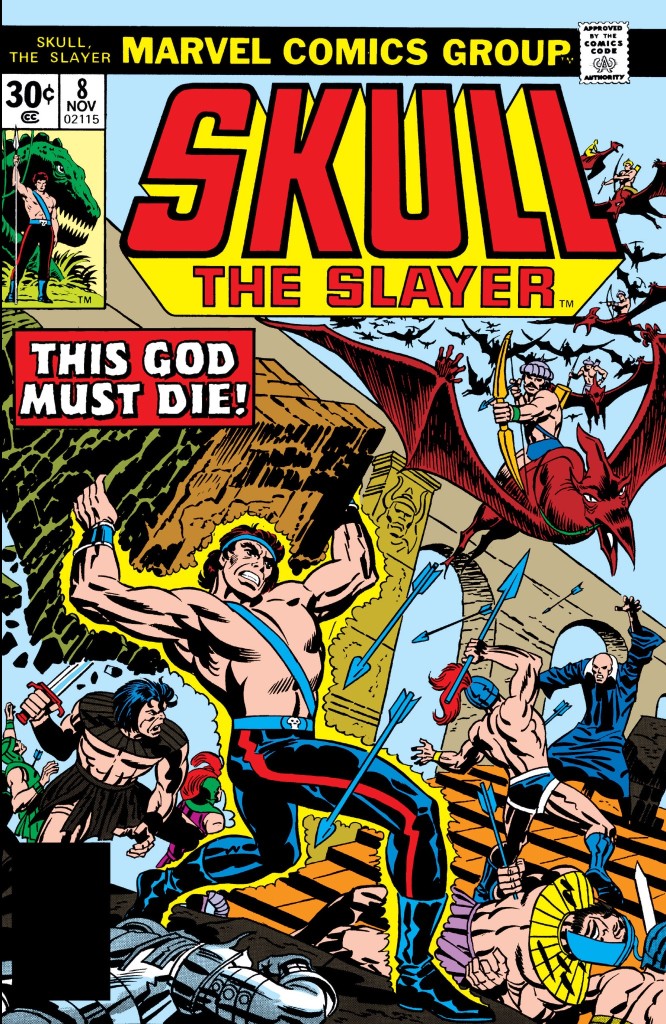
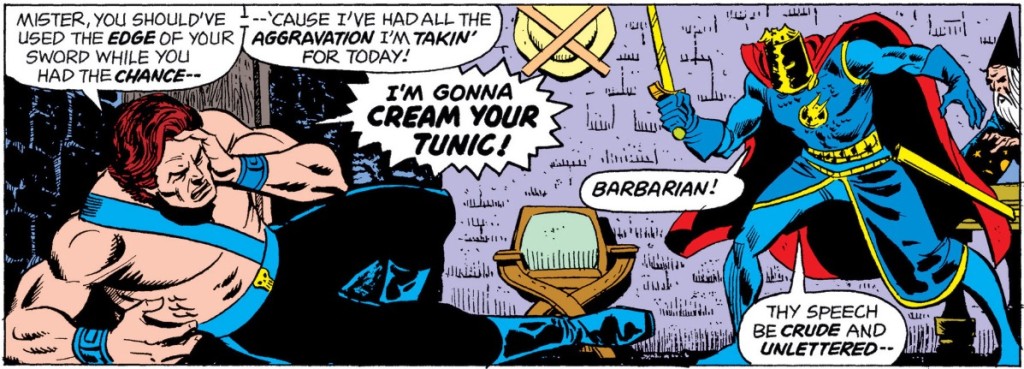
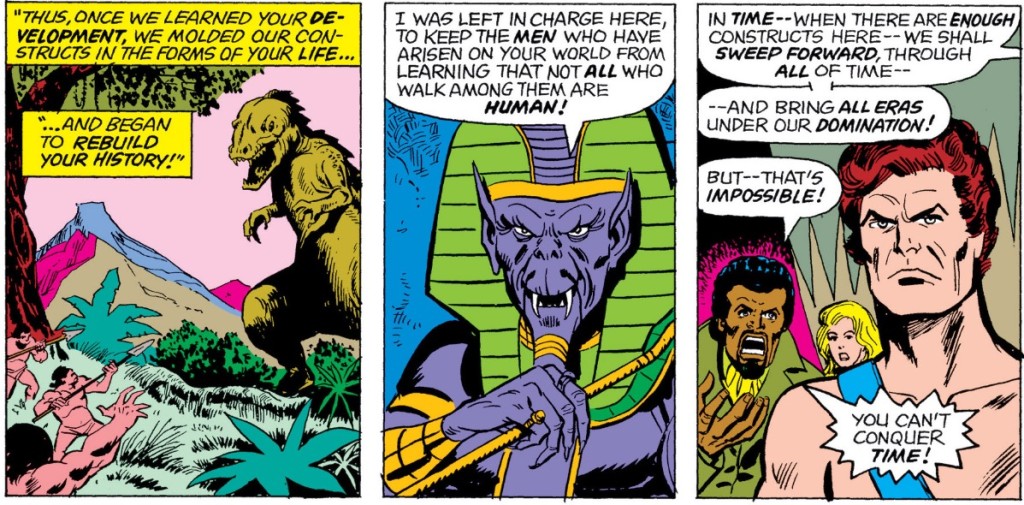
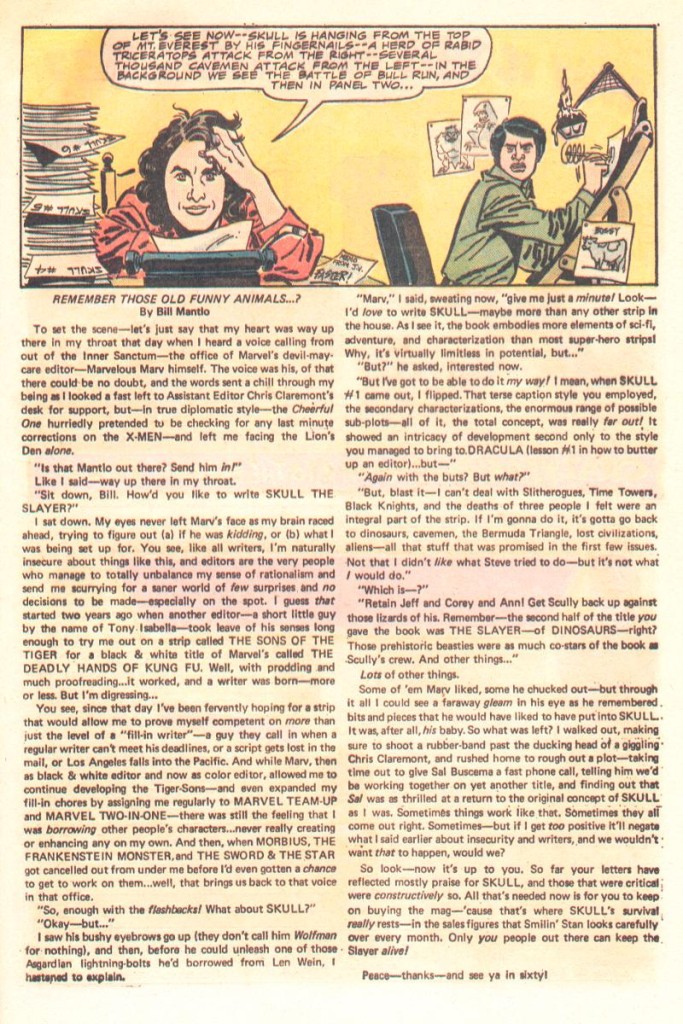
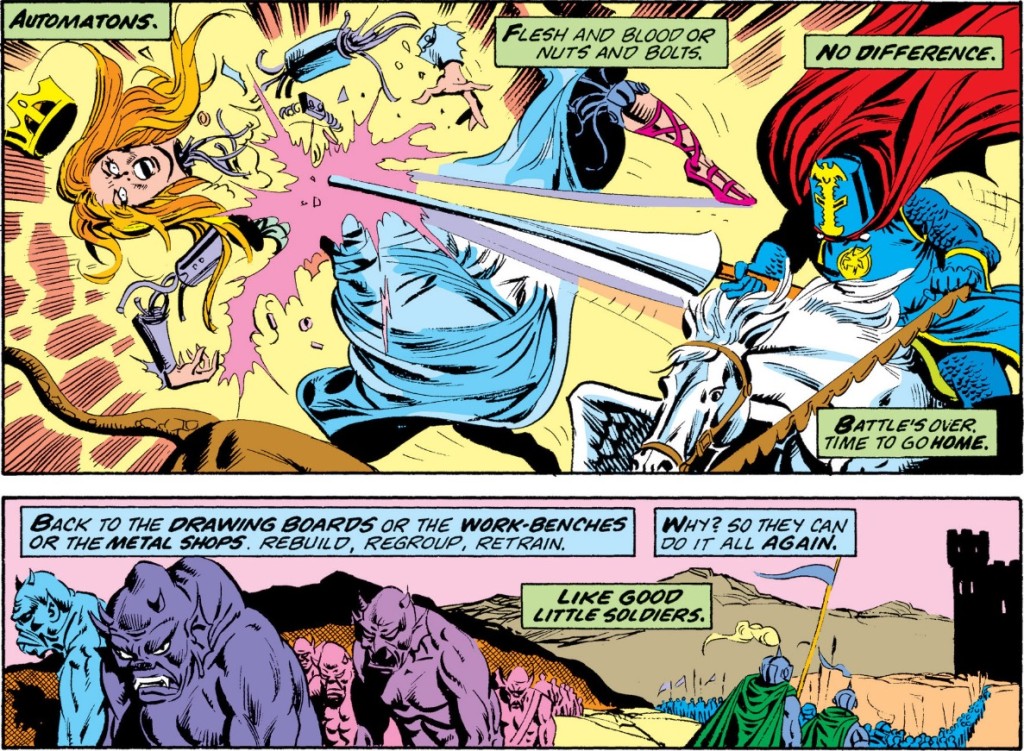
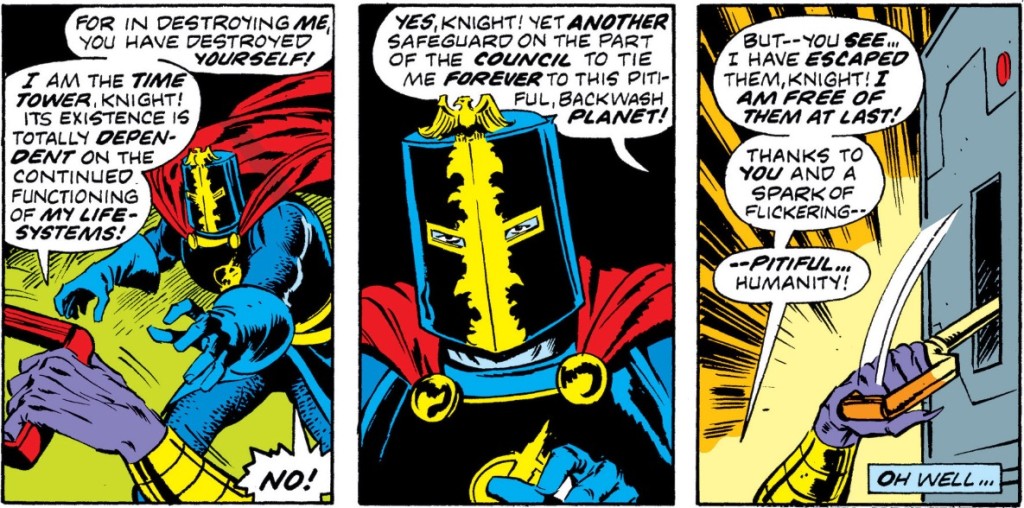
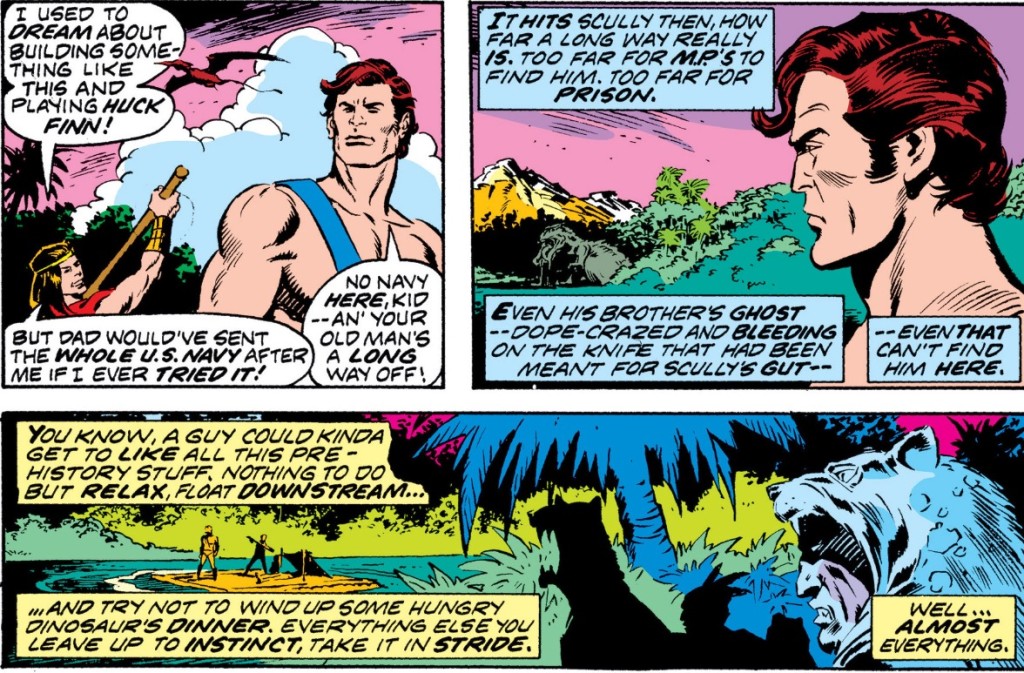
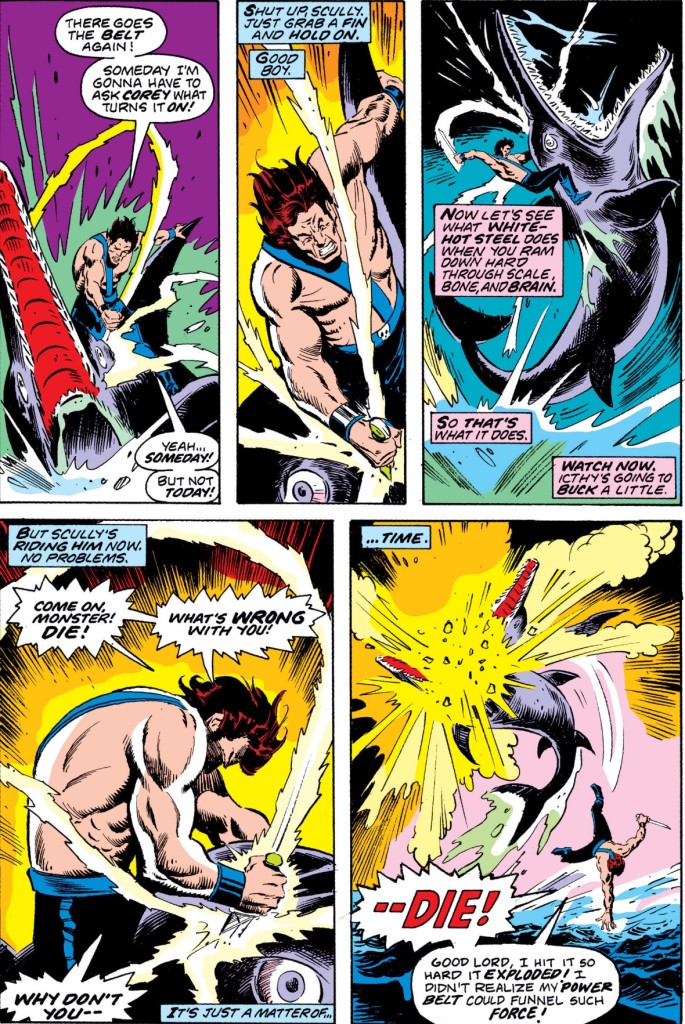
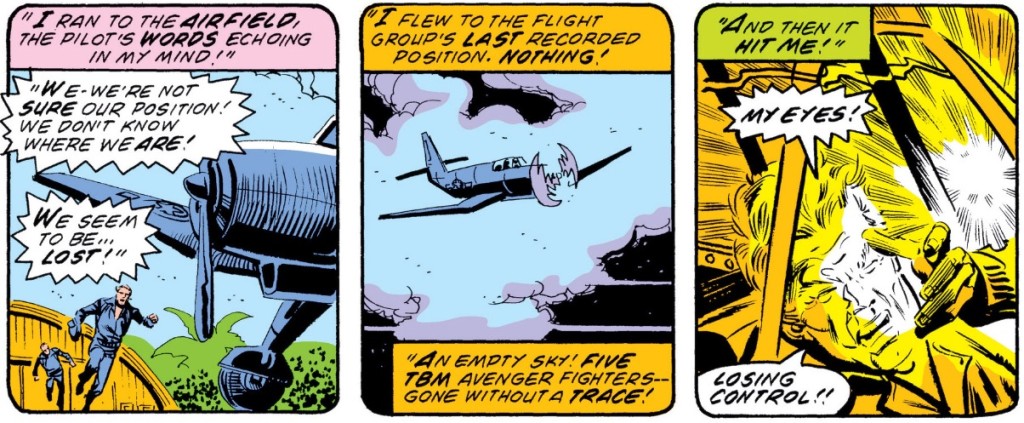
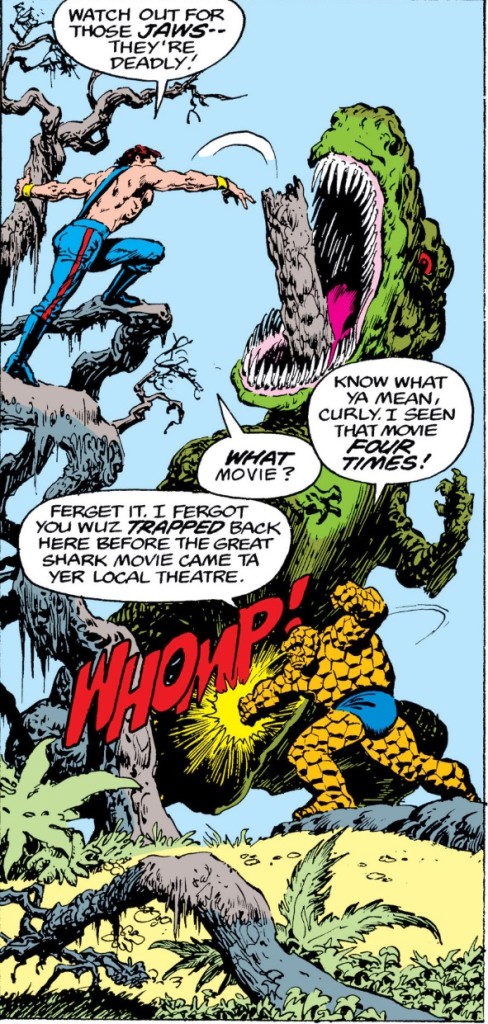
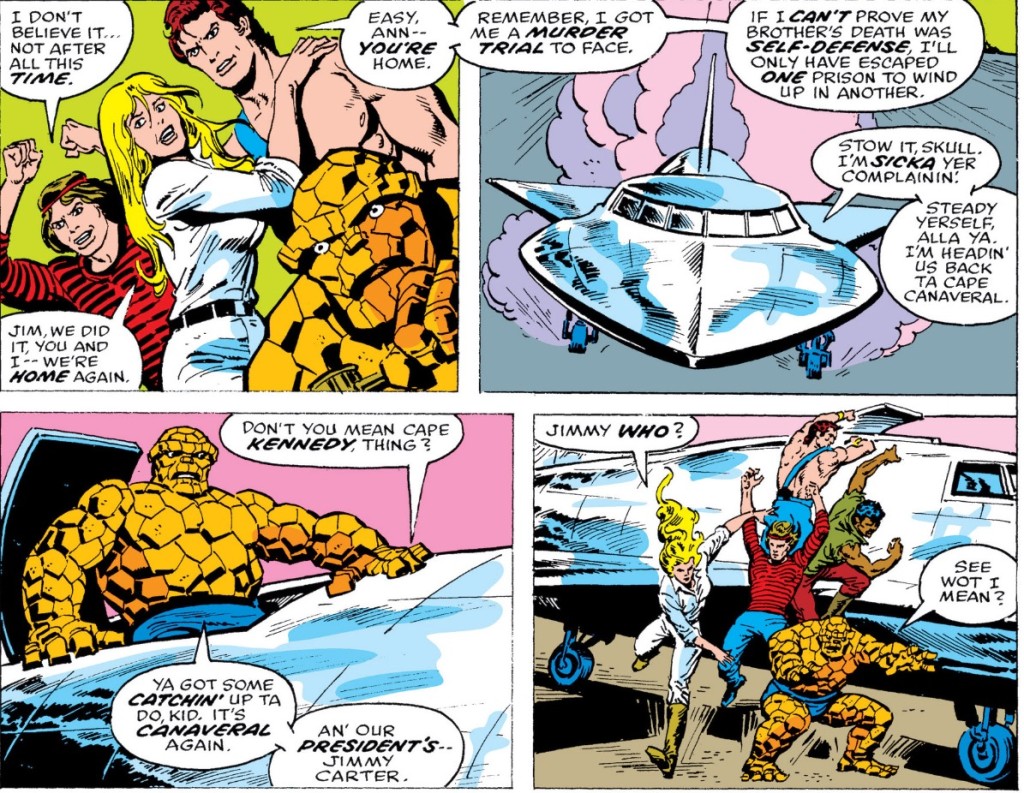


“Slitherogue” is the best name for a prog group that went metal in the early 80’s that never actually existed.
This was an interesting write-up. It’s strange how this book seemed to defeat people you’d think would be pros at picking this up and doing something interesting with it for a few issues and yet . . .they don’t. Mantlo even has that terse, annoyed voice he had in his later ALPHA FLIGHT issues, when he hates the book and really doesn’t want to be there.
That said, that MARVEL TWO IN ONE issue’s art is gorgeous. I wish the Filipino artists had gotten more traction back in the 70s and been as influential as Byrne and Cockrum and the like. There’s a lush, illustrative quality to it.
Great series–I knew next to nothing about SKULL THE SLAYER before, and this series is really intriguing. Are you gonna cover the whole Blazing Skull thing?
Interesting observation about that terse Mantlo voice: I thought he was trying to capture that sardonic edge Wolfman brought to the first few issues, but you might be right.
As for the Blazing Skull…well, we’ll see. I really need to run the character’s appearance list against the title on Marvel Unlimited and see what I come up with.
Thanks for the comment!
Later on in the dwindling issues of Alpha Flight, Mantlo adopted a version of what Rachel and Miles call “The Sarcastic Narrator Voice” because he doesn’t want to be on the book anymore and he’s just putting these characters through hell just to mess around with them.
He doesn’t hide being fed up with a concept too well, I don’t think.